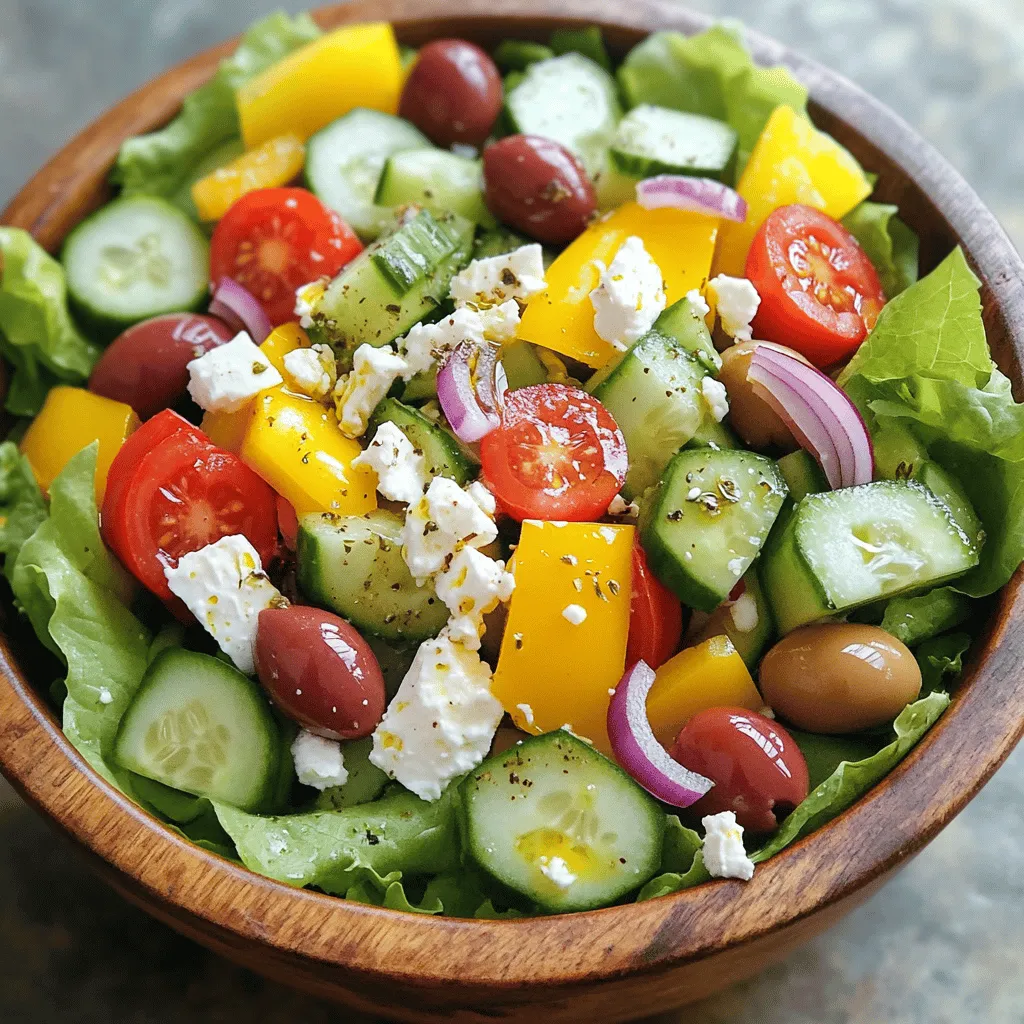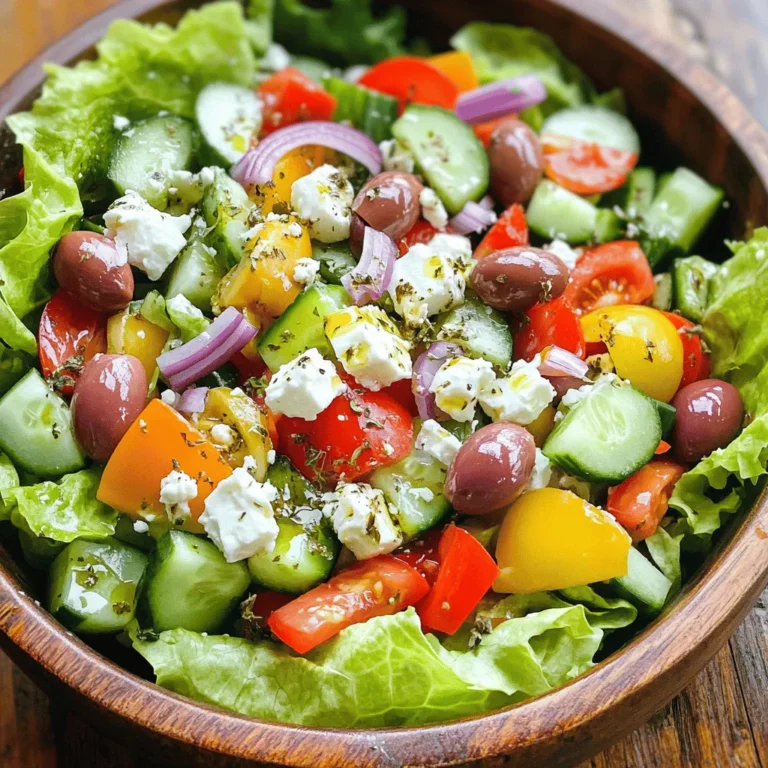Are you ready to dive into a world of vibrant flavors with a classic Greek salad? This dish bursts with freshness from crisp romaine lettuce, juicy tomatoes, and tangy feta cheese. You’ll learn how to assemble this colorful meal that is not only satisfying but also super easy to make. Let’s explore the essential ingredients, step-by-step instructions, and creative variations to capture that sunny Mediterranean spirit right in your kitchen!
Ingredients
Fresh Produce
For a bright taste, use fresh produce. The key ingredients include:
– 3 cups Romaine lettuce, chopped
– 1 large cucumber, diced
– 2 ripe tomatoes, diced
– 1 bell pepper (any color), chopped
– 1 small red onion, thinly sliced
These veggies bring crunch and color. Romaine lettuce serves as a great base. Cucumbers add a refreshing bite. Tomatoes provide sweetness, while bell peppers bring a slight crunch. The red onion adds a sharp flavor that makes the salad pop.
Cheeses and Olives
Feta cheese and Kalamata olives are essential! You want:
– 1 cup Kalamata olives, pitted
– 1 cup feta cheese, crumbled
Feta cheese gives a creamy texture. It also adds saltiness that balances the salad. Kalamata olives add a rich, briny flavor. These ingredients work together to give the salad depth.
Dressings and Seasoning
A great dressing ties everything together. For this salad, use:
– 1/4 cup olive oil
– 2 tablespoons red wine vinegar (or lemon juice)
– 1 teaspoon dried oregano
– Salt and pepper to taste
Olive oil adds richness. Red wine vinegar or lemon juice adds tang. Dried oregano gives a classic Mediterranean flavor. Don’t forget salt and pepper to enhance all the tastes!
Step-by-Step Instructions
Preparing the Salad Base
1. Start by taking 3 cups of chopped Romaine lettuce. This is the base of your salad. Place it in a large salad bowl.
2. Next, layer the diced cucumber, ripe tomatoes, and chopped bell pepper on top of the lettuce. Each adds crunch and color.
Adding Toppings
1. Now, slice a small red onion thinly. Add it to the mix for a nice bite.
2. Toss in 1 cup of pitted Kalamata olives. They bring a salty richness to the dish.
3. Finally, sprinkle 1 cup of crumbled feta cheese on top. This adds creaminess and flavor.
Making the Dressing
1. In a small bowl, whisk together 1/4 cup of olive oil, 2 tablespoons of red wine vinegar (or lemon juice), and 1 teaspoon of dried oregano.
2. Add salt and pepper to taste. Mix until all ingredients blend well.
3. Drizzle the dressing over the salad.
Tossing and Serving
1. Gently mix the salad. Be careful not to break the feta cheese.
2. Serve immediately for the best taste. You can also chill it for 15 minutes to let the flavors meld.Enjoy your vibrant and fresh Classic Greek Salad!
Tips & Tricks
Ingredient Substitutions
If you can’t find feta cheese, try using goat cheese or ricotta. Both add creaminess. For olives, Kalamata is classic, but green olives work too. Try pimento-stuffed olives for a twist.
Perfecting the Dressing
To customize flavors, add fresh herbs like basil or dill. You can also use lemon juice instead of vinegar for a brighter taste. If you want to make the dressing ahead of time, store it in a jar. Shake it before using.
Serving Ideas
Serve Greek salad with grilled chicken or fish for a full meal. It pairs well with pita bread and hummus. For a light lunch, enjoy it alone or with crusty bread. For a fun twist, try it in a wrap!

Variations
Mediterranean Additions
You can make your Greek salad even tastier. Try adding artichoke hearts. They give a nice tangy flavor. Roasted red peppers also work well. They add a sweet touch and vibrant color.
Protein Boosters
Want to make your salad more filling? Include grilled chicken. It adds protein and makes the salad hearty. If you’re vegetarian, try chickpeas or lentils. They are excellent choices for protein and add texture.
Alternative Dressings
The classic olive oil dressing is great, but you can switch it up. A lemon vinaigrette adds a bright, zesty flavor. You can also try a yogurt-based dressing. It gives a creamy texture and is still light.
Storage Info
Storing Leftovers
To store leftover Greek salad, use a clean, airtight container. This keeps the salad fresh and prevents odors. Place the salad in the fridge right away. It stays good for up to three days. However, the veggies may lose some crunch over time.
Freezing Considerations
Greek salad does not freeze well. The vegetables get mushy after thawing. If you need to freeze, consider freezing only the dressing. Store it in a separate container. Use it later to freshen up a new batch of salad.
Reheating Instructions
You don’t need to heat Greek salad. It tastes best cold. If you must, gently microwave it for a few seconds. This helps keep the veggies crisp. However, I recommend enjoying it fresh for the best flavor and texture.
FAQs
What is the history of Greek salad?
Greek salad, or Horiatiki, dates back to the 19th century. It reflects the fresh, local ingredients of Greece. Farmers made it using what they had. This salad shows the connection to their land and culture. It’s a staple in Greek homes and tavernas. Today, it symbolizes Mediterranean dining’s simplicity and health.
Can I make Greek salad ahead of time?
Yes, you can prepare Greek salad ahead of time. To save time, chop your veggies and store them in the fridge. Keep the dressing separate until you’re ready to serve. This helps keep everything fresh. If you mix the salad too soon, it can get soggy.
How can I make Greek salad vegan?
To make Greek salad vegan, simply omit the feta cheese. You can replace it with vegan cheese or omit it altogether. Use more olives or add chickpeas for protein. For creamy dressing, try using tahini or a cashew cream. These swaps keep the salad tasty and satisfying.
What are the health benefits of Greek salad?
Greek salad packs a nutritional punch. It is low in calories and high in vitamins. Ingredients like tomatoes and cucumbers provide hydration. Feta adds protein and calcium. Olives offer healthy fats. Overall, this salad is great for heart health and weight management. It’s a perfect choice for a balanced meal.
This blog post covered how to make a fresh and tasty Greek salad. We highlighted key ingredients, from crisp veggies to creamy feta. You learned step-by-step how to prepare, dress, and serve this dish. We also shared tips for substitutions and variations to match your taste. Remember, Greek salad is not just easy to make. It’s healthy and very versatile! Enjoy creating your own version and sharing it with others. Your kitchen can be a place for delicious, healthy meals that everyone will love.


